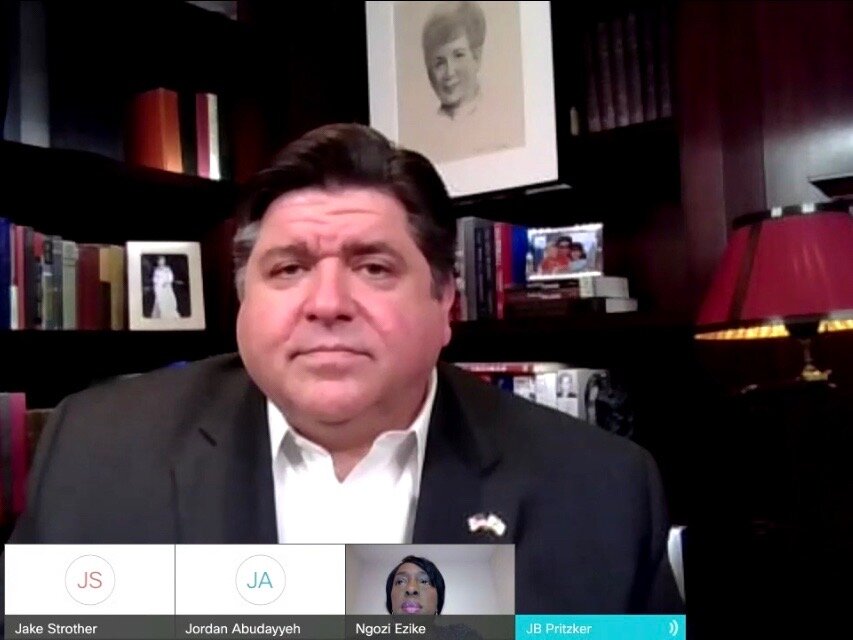Slower rise means later peak on COVID-19
Although some may find that ‘disheartening,’ Pritzker insists state seems headed to next recovery phase at end of May
Gov. Pritzker and Dr. Ngozi Ezike held Monday’s coronavirus briefing remotely from their homes in self-isolation after a Thompson Center staffer tested positive for COVID-19 last week. (Illinois.gov)
By Ted Cox
The slowed rise in COVID-19 infections means a later peak in cases statewide, the governor said Monday, but he nonetheless expressed optimism about moving on to the next phase of the Restore Illinois recovery plan at the end of the month.
Admitting that a peak predicted for mid-May might actually be delayed until a month later due to successful mitigation efforts under the stay-at-home order, Pritzker said, “In many ways, this news is disheartening. We have made great progress, but it has forced us to remain at a moderated though still high level of key metrics for this extended period. A pushing out of our estimated peak is a natural consequence of flattening the curve.
“A slower rate of infections over a longer period of time,” he added, “might not sound like good news to some, but I promise you it is saving lives.”
Pritzker held Monday’s daily coronavirus briefing from an office in his Chicago home after a staffer at the Thompson Center tested positive for COVID-19 last week. Pritzker said, “I feel fine and have tested negative,” although he and Public Health Director Dr. Ngozi Ezike are both self-isolating at home as a precaution.
Ezike reported Monday that infections and deaths from COVID-19 both remained lower than the plateau the state appeared to have reached last week. The state confirmed 1,266 new cases, to push the Illinois total to 79,007, while 54 new deaths brought the statewide toll to 3,459. The 10.2 percent positive rate made the third straight day that statistic declined.
“On a statewide basis, we haven’t passed the peak yet,” Pritzker said, but he insisted that his metrics for moving through the Restore Illinois phases — allowing for a four-week plateau to ease restrictions, rather than demanding a two-week decline — made for a “much easier metric” to achieve, with the earliest date for easing current restrictions being May 29.
According to Pritzker, due to the stay-at-home order and social distancing the number of people infected on average by each COVID-19 patient had dropped from 3.6 to one. He added that, once it falls below that figure, “that will be very good news.”
The latest models projecting the estimated course of the COVID-19 outbreak in Illinois. (State of Illinois)
Ezike reported that hospitalizations for COVID-19 declined, and Pritzker said that all four regions across the state were holding to hospitalization levels that would allow a move on to the third phase in the Restore Illinois plan — allowing hair salons and barber shops to reopen, although not restaurants. The exception was the northeast region including Chicago and its suburbs, he added, which thus far has maintained a positive test rate above 20 percent.
But Chicago Mayor Lori Lightfoot announced Monday that the city is ramping up testing at six new sites, including White Sox Park and others set in minority neighborhoods that have been hit hard by the pandemic. Pritzker applauded that, saying, “The more testing the better. No doubt about it.”
Pritzker was firm on not reopening restaurants, however.
“Lifting all of our mitigations at the end of May would likely lead to a second wave of outbreaks in each and every one of our four regions,” he said. “We all have the same goal, which is to get people back to work, but do it safely.”
Ezike said she found reports of churches holding services in person on Sunday “deeply concerning and troubling,” while Pritzker said reports that Quincy restaurants were reopening put both that Mississippi River town and the entire central region of the state at risk of not moving into the next phase at the end of the month.
“People who open their businesses at this time, knowing that the mitigations are just now beginning to help us bend the curve down … by opening early they’re putting people at risk,” Pritzker said. “The potential here is that we’ll have an upsurge in Quincy of cases and hospitalizations, and that will drive that whole region potentially to a point where it may not reopen. So I think they’re putting people at risk, and they’re putting the entire region’s economy at risk by opening early.
“The intention here is to stick to the plan,” he added.
Ezike said the state had received the first federal delivery of remdesivir, a drug that’s been successful at speeding recovery from COVID-19. She said the state had received 140 cases — each capable of treating about five patients — and they’d already been distributed to 14 hospitals across the state.
Pritzker acknowledged “some glitches again with phone calls today” as the Illinois Department of Employment Security began to process benefits for independent contractors, freelancers, and so-called gig workers idled by the coronavirus pandemic, but he said 44,000 people had gotten through to file for the expanded unemployment under a federal COVID-19 relief package.


